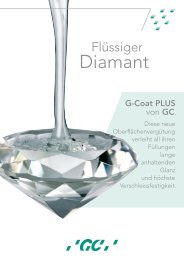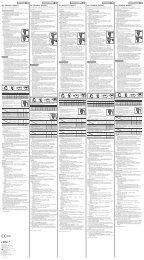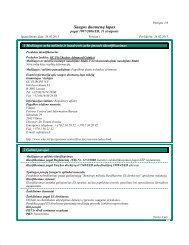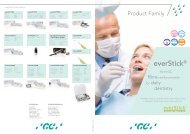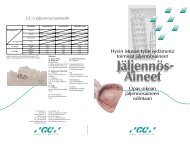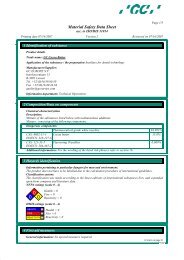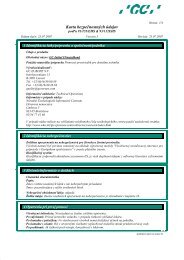You also want an ePaper? Increase the reach of your titles
YUMPU automatically turns print PDFs into web optimized ePapers that Google loves.
9. QUESTIONS & ANSWERS<br />
Q1. After sandblasting, if alloy surface is touched with fingers will bond strength of<br />
<strong>GC</strong> METALPRIMER II be affected?<br />
A1. Yes. Sandblast alloy surface again and reapply <strong>GC</strong> METALPRIMER II.<br />
Q2. Should sandblasted metal be ultrasonic or steam cleaned?<br />
A2. No! The water may contain oil. Simply use filtered air pressure to remove aluminium<br />
oxide residue.<br />
Q3. Opaque is a little thick when dispensing from syringe. Is this a problem?<br />
A3. Not a problem! <strong>GC</strong> <strong>GRADIA</strong> pastes are thixotropic (certain gels exhibit this property<br />
but they become more fluid when stirred or put into motion, e.g. a syringe plunger).<br />
The thixotropic property helps control flow and prevents OPAQUE from pooling in<br />
undesired areas.<br />
Q4. Can OPAQUE be diluted to improve flow?<br />
A4. No, other than stirring it with a brush or spatula. <strong>GC</strong> COMPOSITE PRIMER and/or<br />
<strong>GC</strong> <strong>GRADIA</strong> INTENSIVE COLORS should not be used to dilute opaque pastes.<br />
Q5. Can OPAQUE tooth shade be used instead of FOUNDATION OPAQUE?<br />
A5. Yes, but it may require four very thin layers (each layer being light cured) in order to<br />
polymerize fully in undercut areas.<br />
Q8. Is there a way of preventing cracks in composite bridges?<br />
A8. Yes,<br />
a) Avoid applying large amounts of resin at one time between light cures.<br />
b) Create breaks where materials overlap.<br />
c) Build veneer by applying several thin layers, light curing them at each stage.<br />
Q9. How can entrapping air bubbles be prevented?<br />
A9. There are two ways:<br />
1.Before applying resin, lightly tap top of the paste surface with a spatula (spatula<br />
edge should not be nicked or rough. That will cause bubbles).<br />
2.Apply thin coat of <strong>GC</strong> COMPOSITE PRIMER to roughened resin surface. Light cure<br />
1 min. before applying next paste layer.<br />
Q10. Which paste should be used on hollow part of a pontic?<br />
A10. Build-up with TRANSLUCENT. Contour to conform to adjacent area, light cure, then<br />
apply OPAQUE and light cure again.<br />
Q11. Which light curing unit should be used?<br />
A11. Those compatible with <strong>GC</strong> <strong>GRADIA</strong> – <strong>GC</strong> LABOLIGHT LV-III, <strong>GC</strong> STEPLIGHT SL-I.<br />
Units radiating ultraviolet light can not be used. They may cure surface monomer<br />
excessively, creating a non-bonding barrier between it and the next composite layer.<br />
Q6. Is it possible to cover to the top of RETENTION BEADS II SSS with a single layer<br />
of FOUNDATION OPAQUE?<br />
A6. Yes! The SSS BEADS are 100μ, the curing depth of FOUNDATION OPAQUE is 300μ. A<br />
single layer of FOUNDATION OPAQUE will be polymerized correctly in the underent<br />
areas of the RETENTION BEADS II SSS.<br />
Q12. Can the brushes be cleaned?<br />
A12. Yes! Clean thoroughly with pure alcohol (ethanol) after applying <strong>GC</strong> METALPRIMER II,<br />
<strong>GC</strong> <strong>GRADIA</strong> DIE HARDNER, <strong>GC</strong> <strong>GRADIA</strong> SEPARATOR, OPAQUES. Make sure that the<br />
ethanol dries off before re-using the tools. After using <strong>GC</strong> <strong>GRADIA</strong> AIR BARRIER, wash<br />
brush thoroughly with water.<br />
Q7. OPAQUE did not cure.<br />
A7. The OPAQUE layer might be too thick. Remove it and apply two very thin layers<br />
instead of one thick layer.<br />
Q13. Is it hard to remove composite inlays from working model?<br />
A13. No! Apply <strong>GC</strong> <strong>GRADIA</strong> DIE HARDNER, block-out undercuts with wax then apply the<br />
<strong>GC</strong> <strong>GRADIA</strong> SEPARATOR.<br />
31



